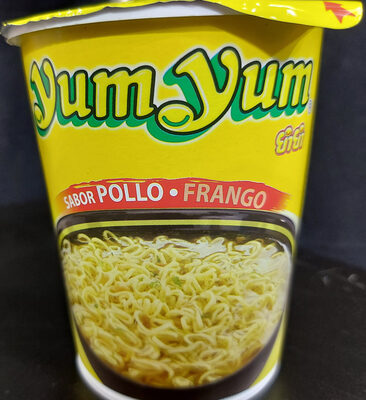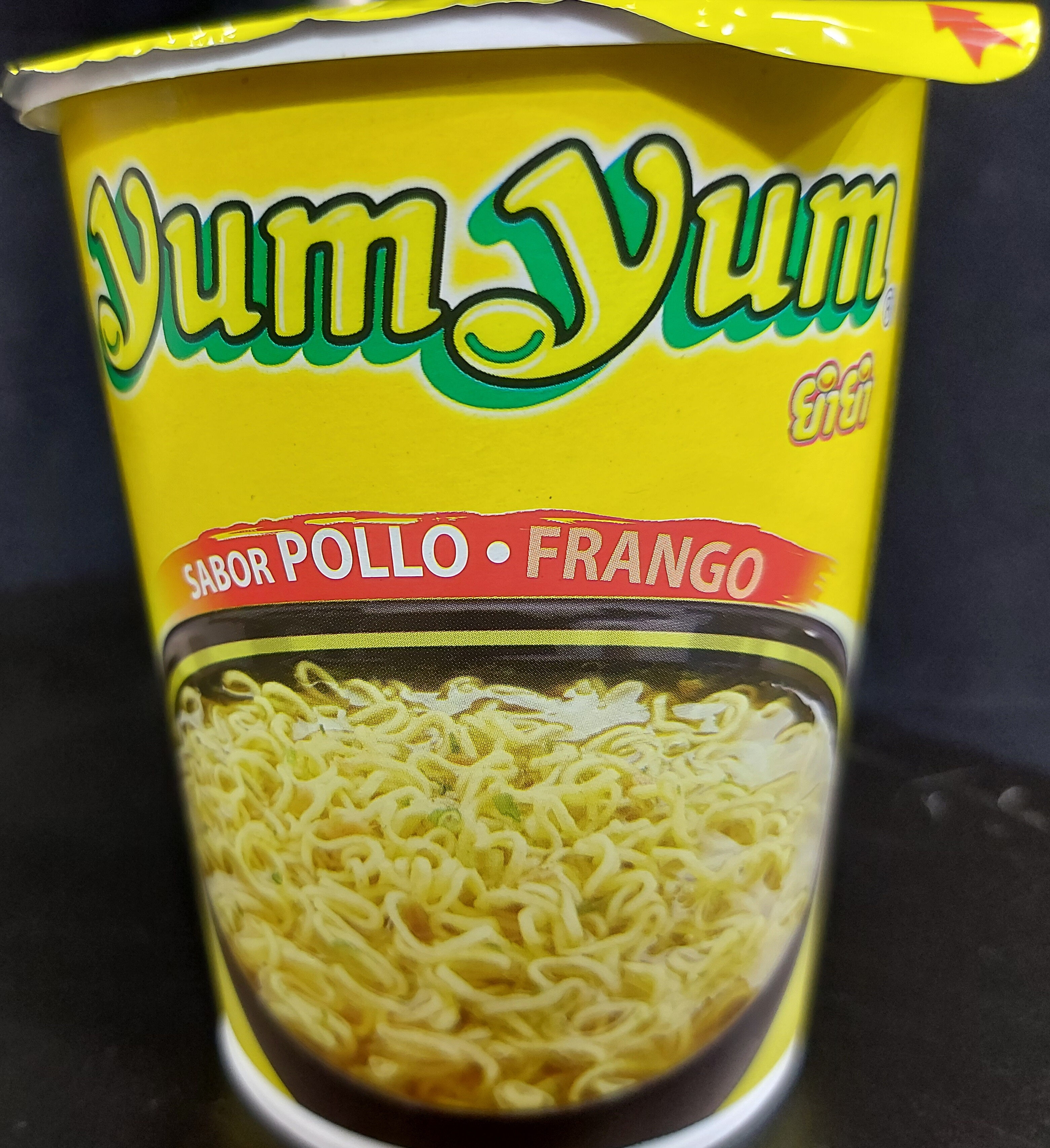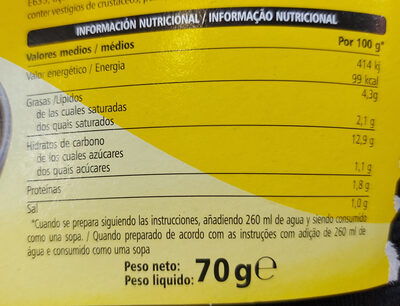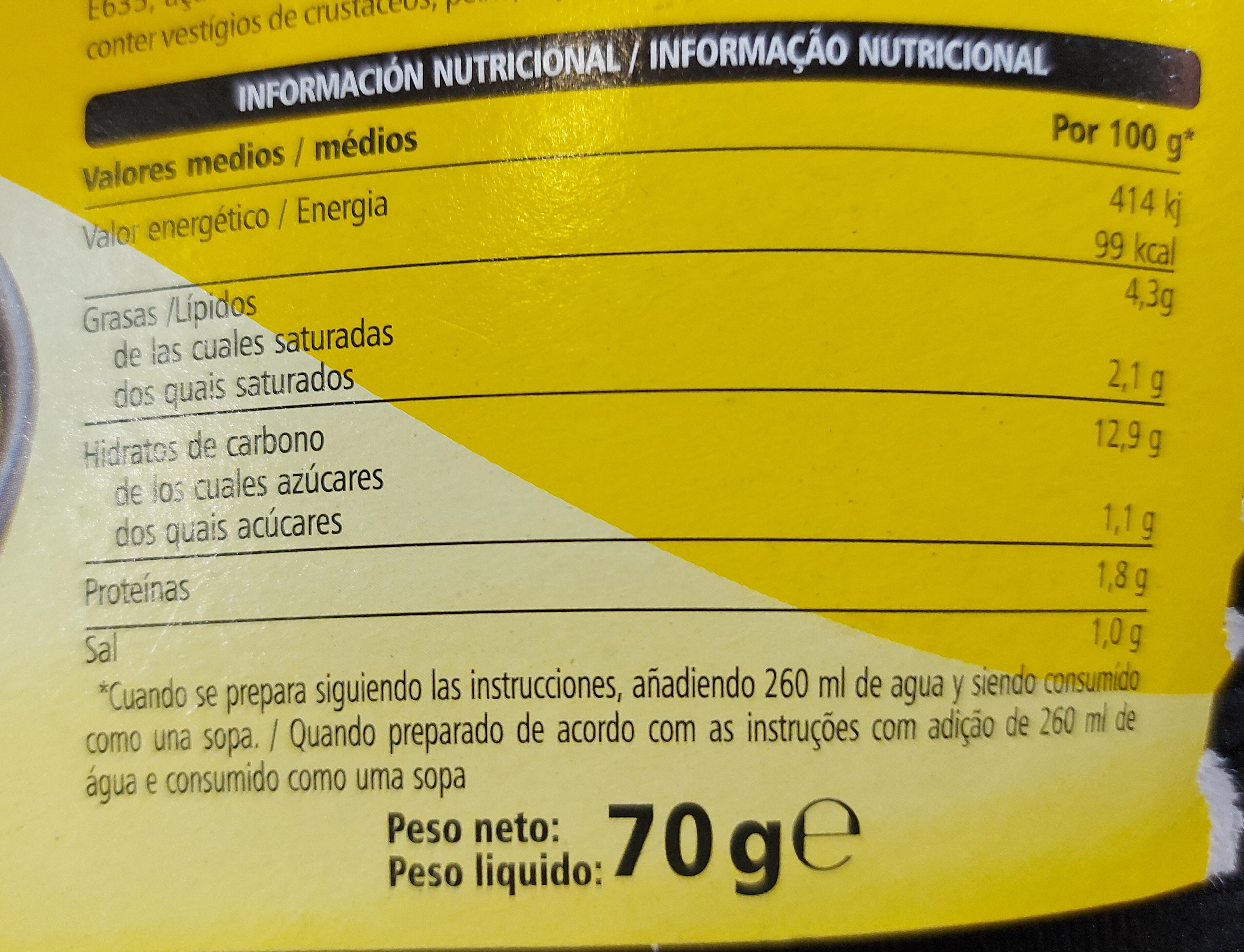Help us make food transparency the norm!
As a non-profit organization, we depend on your donations to continue informing consumers around the world about what they eat.
The food revolution starts with you!
fideos instantáneo - yum yum - 70 g
fideos instantáneo - yum yum - 70 g
Ambiguous barcode: This product has a Restricted Circulation Number barcode for products within a company. This means that different producers and stores can use the same barcode for different products.
×
This product page is not complete. You can help to complete it by editing it and adding more data from the photos we have, or by taking more photos using the app for Android or iPhone/iPad. Thank you!
×
Barra-kodea: 09403451
Kopurua: 70 g
Ontziratzea: en:Plastic
Markak: yum yum
Kategoriak: en:Plant-based foods and beverages, en:Plant-based foods, en:Cereals and potatoes, en:Cereals and their products, en:Dried products, Pasta, en:Dried products to be rehydrated, en:Noodles, en:Instant noodles, en:Instant noodle soups
Manufacturing or processing places: Bangkok
Dendak: Mercadona
Saltzen diren herrialdeak: Espainia
Matching with your preferences
Health
Osagaiak
-
44 ingredients
: Fideo harina de trigo, aceite de palma (aceite de paima, antoxidante : E319), almión de, tapioca, sope aromatizntes, potendadores del sabor. E635, extracto de levadura), sal, reguladores de la acidez: E500, E452, E451, espesantes: E466. Condimentos: verduras (zanahoria, ajo, maíz, cebolleta), aceite de palma (aceite de palma, antioxidante : E320), sal, potenciadores del sabor. E621, 635, azúcar, car, polvo de pimienta, ácidos: £296, aroma de pollo. Este producto puede contener trazas de soja, Custáceos, pesco leche, apio, sésamo y huevo. ONOODLES INSTANTÂNEOS SABOR FRANGOAlergenoak: en:CeleryAztarnak: en:Celery, en:Crustaceans, en:Eggs, en:Sesame seeds, en:Soybeans, es:pescado-leche-apio, es:sesamo-huevo
Food processing
-
Ultra processed foods
Elements that indicate the product is in the 4 - Ultra prozesatutako elikagaiak eta edariak group:
- Gehigarria: E451
- Gehigarria: E452
- Gehigarria: E466
- Gehigarria: E621
- Gehigarria: E635
- Osagaia: Flavour enhancer
- Osagaia: Thickener
Food products are classified into 4 groups according to their degree of processing:
- Prozesatu gabeko edo ahalik eta gutxien prozesatutako elikagaiak
- Sukaldaritzako osagaiak prozesatu
- Prozesatutako jakiak
- Ultra processed foods
The determination of the group is based on the category of the product and on the ingredients it contains.
Gehigarriak
-
E319
Tert-Butylhydroquinone: tert-Butylhydroquinone -TBHQ, tertiary butylhydroquinone- is a synthetic aromatic organic compound which is a type of phenol. It is a derivative of hydroquinone, substituted with a tert-butyl group.Source: Wikipedia (Ingeles)
-
E320
Butylated hydroxyanisole: Butylated hydroxyanisole -BHA- is an antioxidant consisting of a mixture of two isomeric organic compounds, 2-tert-butyl-4-hydroxyanisole and 3-tert-butyl-4-hydroxyanisole. It is prepared from 4-methoxyphenol and isobutylene. It is a waxy solid used as a food additive with the E number E320. The primary use for BHA is as an antioxidant and preservative in food, food packaging, animal feed, cosmetics, rubber, and petroleum products. BHA also is commonly used in medicines, such as isotretinoin, lovastatin, and simvastatin, among others.Source: Wikipedia (Ingeles)
-
E451
Sodium triphosphate: Sodium triphosphate -STP-, also sodium tripolyphosphate -STPP-, or tripolyphosphate -TPP-,- is an inorganic compound with formula Na5P3O10. It is the sodium salt of the polyphosphate penta-anion, which is the conjugate base of triphosphoric acid. It is produced on a large scale as a component of many domestic and industrial products, especially detergents. Environmental problems associated with eutrophication are attributed to its widespread use.Source: Wikipedia (Ingeles)
-
E466
Carboxymethyl cellulose: Carboxymethyl cellulose -CMC- or cellulose gum or tylose powder is a cellulose derivative with carboxymethyl groups --CH2-COOH- bound to some of the hydroxyl groups of the glucopyranose monomers that make up the cellulose backbone. It is often used as its sodium salt, sodium carboxymethyl cellulose.Source: Wikipedia (Ingeles)
-
E500
Sodium carbonate: Sodium carbonate, Na2CO3, -also known as washing soda, soda ash and soda crystals, and in the monohydrate form as crystal carbonate- is the water-soluble sodium salt of carbonic acid. It most commonly occurs as a crystalline decahydrate, which readily effloresces to form a white powder, the monohydrate. Pure sodium carbonate is a white, odorless powder that is hygroscopic -absorbs moisture from the air-. It has a strongly alkaline taste, and forms a moderately basic solution in water. Sodium carbonate is well known domestically for its everyday use as a water softener. Historically it was extracted from the ashes of plants growing in sodium-rich soils, such as vegetation from the Middle East, kelp from Scotland and seaweed from Spain. Because the ashes of these sodium-rich plants were noticeably different from ashes of timber -used to create potash-, they became known as "soda ash". It is synthetically produced in large quantities from salt -sodium chloride- and limestone by a method known as the Solvay process. The manufacture of glass is one of the most important uses of sodium carbonate. Sodium carbonate acts as a flux for silica, lowering the melting point of the mixture to something achievable without special materials. This "soda glass" is mildly water-soluble, so some calcium carbonate is added to the melt mixture to make the glass produced insoluble. This type of glass is known as soda lime glass: "soda" for the sodium carbonate and "lime" for the calcium carbonate. Soda lime glass has been the most common form of glass for centuries. Sodium carbonate is also used as a relatively strong base in various settings. For example, it is used as a pH regulator to maintain stable alkaline conditions necessary for the action of the majority of photographic film developing agents. It acts as an alkali because when dissolved in water, it dissociates into the weak acid: carbonic acid and the strong alkali: sodium hydroxide. This gives sodium carbonate in solution the ability to attack metals such as aluminium with the release of hydrogen gas.It is a common additive in swimming pools used to raise the pH which can be lowered by chlorine tablets and other additives which contain acids. In cooking, it is sometimes used in place of sodium hydroxide for lyeing, especially with German pretzels and lye rolls. These dishes are treated with a solution of an alkaline substance to change the pH of the surface of the food and improve browning. In taxidermy, sodium carbonate added to boiling water will remove flesh from the bones of animal carcasses for trophy mounting or educational display. In chemistry, it is often used as an electrolyte. Electrolytes are usually salt-based, and sodium carbonate acts as a very good conductor in the process of electrolysis. In addition, unlike chloride ions, which form chlorine gas, carbonate ions are not corrosive to the anodes. It is also used as a primary standard for acid-base titrations because it is solid and air-stable, making it easy to weigh accurately.Source: Wikipedia (Ingeles)
-
E621
Monosodium glutamate: Monosodium glutamate -MSG, also known as sodium glutamate- is the sodium salt of glutamic acid, one of the most abundant naturally occurring non-essential amino acids. Glutamic acid is found naturally in tomatoes, grapes, cheese, mushrooms and other foods.MSG is used in the food industry as a flavor enhancer with an umami taste that intensifies the meaty, savory flavor of food, as naturally occurring glutamate does in foods such as stews and meat soups. It was first prepared in 1908 by Japanese biochemist Kikunae Ikeda, who was trying to isolate and duplicate the savory taste of kombu, an edible seaweed used as a base for many Japanese soups. MSG as a flavor enhancer balances, blends, and rounds the perception of other tastes.The U.S. Food and Drug Administration has given MSG its generally recognized as safe -GRAS- designation. A popular belief is that large doses of MSG can cause headaches and other feelings of discomfort, known as "Chinese restaurant syndrome," but double-blind tests fail to find evidence of such a reaction. The European Union classifies it as a food additive permitted in certain foods and subject to quantitative limits. MSG has the HS code 29224220 and the E number E621.Source: Wikipedia (Ingeles)
Ingredients analysis
-
en:Palm oil
Ingredients that contain palm oil: Palmondo olio, Palmondo olio, Palmondo olio
-
en:Non-vegan
Non-vegan ingredients: ArrautzaSome ingredients could not be recognized.
We need your help!
You can help us recognize more ingredients and better analyze the list of ingredients for this product and others:
- Edit this product page to correct spelling mistakes in the ingredients list, and/or to remove ingredients in other languages and sentences that are not related to the ingredients.
- Add new entries, synonyms or translations to our multilingual lists of ingredients, ingredient processing methods, and labels.
If you would like to help, join the #ingredients channel on our Slack discussion space and/or learn about ingredients analysis on our wiki. Thank you!
-
en:Vegetarian status unknown
Unrecognized ingredients: es:fideo-harina-de-trigo, es:aceite-de-paima, es:antoxidante, es:almion-de, es:sope-aromatizntes, es:potendadores-del-sabor, es:635, es:car, es:296, es:aroma-de-pollo, es:custaceos, es:pesco-leche, es:onoodles-instantaneos-sabor-frangoSome ingredients could not be recognized.
We need your help!
You can help us recognize more ingredients and better analyze the list of ingredients for this product and others:
- Edit this product page to correct spelling mistakes in the ingredients list, and/or to remove ingredients in other languages and sentences that are not related to the ingredients.
- Add new entries, synonyms or translations to our multilingual lists of ingredients, ingredient processing methods, and labels.
If you would like to help, join the #ingredients channel on our Slack discussion space and/or learn about ingredients analysis on our wiki. Thank you!
-
Details of the analysis of the ingredients
We need your help!
Some ingredients could not be recognized.
We need your help!
You can help us recognize more ingredients and better analyze the list of ingredients for this product and others:
- Edit this product page to correct spelling mistakes in the ingredients list, and/or to remove ingredients in other languages and sentences that are not related to the ingredients.
- Add new entries, synonyms or translations to our multilingual lists of ingredients, ingredient processing methods, and labels.
If you would like to help, join the #ingredients channel on our Slack discussion space and/or learn about ingredients analysis on our wiki. Thank you!
: Fideo harina de trigo, aceite de palma (aceite de paima, antoxidante (e319)), almión de, tapioca, sope aromatizntes, potendadores del sabor, e635, extracto de levadura, sal, reguladores de la acidez (e500), e452, e451, espesantes (e466, Condimentos), verduras (zanahoria, ajo, maíz, cebolleta), aceite de palma (aceite de palma, antioxidante (e320)), sal, potenciadores del sabor, e621, 635, azúcar, car, pimienta, ácidos (£296), aroma de pollo, Custáceos, pesco leche, apio, sésamo, huevo, ONOODLES INSTANTÂNEOS SABOR FRANGO- Fideo harina de trigo -> es:fideo-harina-de-trigo - percent_min: 3.33333333333333 - percent_max: 100
- aceite de palma -> en:palm-oil - vegan: yes - vegetarian: yes - from_palm_oil: yes - ciqual_food_code: 16129 - percent_min: 0 - percent_max: 50
- aceite de paima -> es:aceite-de-paima - percent_min: 0 - percent_max: 50
- antoxidante -> es:antoxidante - percent_min: 0 - percent_max: 25
- e319 -> en:e319 - vegan: yes - vegetarian: yes - percent_min: 0 - percent_max: 25
- almión de -> es:almion-de - percent_min: 0 - percent_max: 33.3333333333333
- tapioca -> en:tapioca - vegan: yes - vegetarian: yes - ciqual_proxy_food_code: 9510 - percent_min: 0 - percent_max: 25
- sope aromatizntes -> es:sope-aromatizntes - percent_min: 0 - percent_max: 20
- potendadores del sabor -> es:potendadores-del-sabor - percent_min: 0 - percent_max: 16.6666666666667
- e635 -> en:e635 - vegan: maybe - vegetarian: maybe - percent_min: 0 - percent_max: 14.2857142857143
- extracto de levadura -> en:yeast-extract - vegan: yes - vegetarian: yes - percent_min: 0 - percent_max: 12.5
- sal -> en:salt - vegan: yes - vegetarian: yes - ciqual_food_code: 11058 - percent_min: 0 - percent_max: 1
- reguladores de la acidez -> en:acidity-regulator - percent_min: 0 - percent_max: 1
- e500 -> en:e500 - vegan: yes - vegetarian: yes - percent_min: 0 - percent_max: 1
- e452 -> en:e452 - vegan: yes - vegetarian: yes - percent_min: 0 - percent_max: 1
- e451 -> en:e451 - vegan: yes - vegetarian: yes - percent_min: 0 - percent_max: 1
- espesantes -> en:thickener - percent_min: 0 - percent_max: 1
- e466 -> en:e466 - vegan: yes - vegetarian: yes - percent_min: 0 - percent_max: 1
- Condimentos -> en:condiment - vegan: maybe - vegetarian: maybe - percent_min: 0 - percent_max: 0.5
- verduras -> en:vegetable - vegan: yes - vegetarian: yes - percent_min: 0 - percent_max: 1
- zanahoria -> en:carrot - vegan: yes - vegetarian: yes - ciqual_food_code: 20009 - percent_min: 0 - percent_max: 1
- ajo -> en:garlic - vegan: yes - vegetarian: yes - ciqual_food_code: 11000 - percent_min: 0 - percent_max: 0.5
- maíz -> en:corn - vegan: yes - vegetarian: yes - ciqual_food_code: 9200 - percent_min: 0 - percent_max: 0.333333333333333
- cebolleta -> en:welsh-onion - vegan: yes - vegetarian: yes - ciqual_food_code: 20034 - percent_min: 0 - percent_max: 0.25
- aceite de palma -> en:palm-oil - vegan: yes - vegetarian: yes - from_palm_oil: yes - ciqual_food_code: 16129 - percent_min: 0 - percent_max: 1
- aceite de palma -> en:palm-oil - vegan: yes - vegetarian: yes - from_palm_oil: yes - ciqual_food_code: 16129 - percent_min: 0 - percent_max: 1
- antioxidante -> en:antioxidant - percent_min: 0 - percent_max: 0.5
- e320 -> en:e320 - vegan: yes - vegetarian: yes - percent_min: 0 - percent_max: 0.5
- sal -> en:salt - vegan: yes - vegetarian: yes - ciqual_food_code: 11058 - percent_min: 0 - percent_max: 1
- potenciadores del sabor -> en:flavour-enhancer - percent_min: 0 - percent_max: 1
- e621 -> en:e621 - vegan: yes - vegetarian: yes - percent_min: 0 - percent_max: 1
- 635 -> es:635 - percent_min: 0 - percent_max: 1
- azúcar -> en:sugar - vegan: yes - vegetarian: yes - ciqual_proxy_food_code: 31016 - percent_min: 0 - percent_max: 1
- car -> es:car - percent_min: 0 - percent_max: 1
- pimienta -> en:pepper - vegan: yes - vegetarian: yes - percent_min: 0 - percent_max: 1
- ácidos -> en:acid - percent_min: 0 - percent_max: 1
- £296 -> es:296 - percent_min: 0 - percent_max: 1
- aroma de pollo -> es:aroma-de-pollo - percent_min: 0 - percent_max: 1
- Custáceos -> es:custaceos - percent_min: 0 - percent_max: 1
- pesco leche -> es:pesco-leche - percent_min: 0 - percent_max: 1
- apio -> en:celery - vegan: yes - vegetarian: yes - ciqual_proxy_food_code: 20055 - percent_min: 0 - percent_max: 1
- sésamo -> en:sesame - vegan: yes - vegetarian: yes - ciqual_food_code: 15010 - percent_min: 0 - percent_max: 1
- huevo -> en:egg - vegan: no - vegetarian: yes - ciqual_food_code: 22000 - percent_min: 0 - percent_max: 1
- ONOODLES INSTANTÂNEOS SABOR FRANGO -> es:onoodles-instantaneos-sabor-frango - percent_min: 0 - percent_max: 1
Elikadura
-
Missing data to compute the Nutri-Score
Missing nutrition facts
⚠ ️The nutrition facts of the product must be specified in order to compute the Nutri-Score.Could you add the information needed to compute the Nutri-Score? Add nutrition facts
-
Nutrition facts
Nutrition facts As sold
for 100 g / 100 mlAs sold
per serving (70g)Compared to: en:Instant noodle soups Koipe 4,3 g 3,01 g -% 48 Gantz-azido ase ? ? Carbohydrates 12,09 g 8,46 g -% 62 Azukre 1,1 g 0,77 g -% 45 Fiber ? ? Proteina 1,8 g 1,26 g -% 66 Gatz arrunt 1 g 0,7 g -% 60 Fruits‚ vegetables‚ nuts and rapeseed‚ walnut and olive oils (estimate from ingredients list analysis) 0,006 % 0,006 %
Ingurumena
-
Eco-Score C - Moderate environmental impact
The Eco-Score is an experimental score that summarizes the environmental impacts of food products.→ The Eco-Score was initially developped for France and it is being extended to other European countries. The Eco-Score formula is subject to change as it is regularly improved to make it more precise and better suited to each country.Life cycle analysis
-
Average impact of products of the same category: B (Score: 66/100)
Kategoria: Soup, Asian-style with noodles, prepacked, to be reheated
Kategoria: Soup, Asian-style with noodles, prepacked, to be reheated
- PEF environmental score: 0.38 (the lower the score, the lower the impact)
- including impact on climate change: 3.15 kg CO2 eq/kg of product
Stage Impact Agriculture
59.3 %Processing
25.0 %Ontziratzea
2.6 %Transportation
10.7 %Distribution
1.2 %Consumption
1.1 %
Bonuses and maluses
-
Missing origins of ingredients information
Malus: -5
⚠ ️ The origins of the ingredients of this product are not indicated.
If they are indicated on the packaging, you can modify the product sheet and add them.
If you are the manufacturer of this product, you can send us the information with our free platform for producers.
-
Ingredients that threatens species
Malus: -10
Contains palm oil
Tropical forests in Asia, Africa and Latin America are destroyed to create and expand oil palm tree plantations. The deforestation contributes to climate change, and it endangers species such as the orangutan, the pigmy elephant and the Sumatran rhino.
-
Packaging with a medium impact
Malus: -10
Shape Material Recycling Impact Unknown Plastic Altua ⚠ ️ The information about the packaging of this product is not sufficiently precise (exact shapes and materials of all components of the packaging).⚠ ️ For a more precise calculation of the Eco-Score, you can modify the product page and add them.
If you are the manufacturer of this product, you can send us the information with our free platform for producers.
Eco-Score for this product
-
Impact for this product: C (Score: 41/100)
Produktua: fideos instantáneo - yum yum - 70 g
Life cycle analysis score: 66
Sum of bonuses and maluses: -25
Final score: 41/100
-
Carbon footprint
-
Equal to driving 1.6 km in a petrol car
315 g CO² per 100g of product
The carbon emission figure comes from ADEME's Agribalyse database, for the category: Soup, Asian-style with noodles, prepacked, to be reheated (Source: ADEME Agribalyse Database)
Stage Impact Agriculture
62.1 %Processing
19.1 %Ontziratzea
3.2 %Transportation
14.7 %Distribution
0.5 %Consumption
0.4 %
Ontziratzea
-
Packaging with a medium impact
-
Packaging parts
(Plastic)
-
Bilgarriaren materialak
Material % Bilgarriaren pisua Bilgarriaren pisua produktuaren 100g-ko Plastic
-
Transportation
-
Origins of ingredients
Missing origins of ingredients information
⚠ ️ The origins of the ingredients of this product are not indicated.
If they are indicated on the packaging, you can modify the product sheet and add them.
If you are the manufacturer of this product, you can send us the information with our free platform for producers.Add the origins of ingredients for this product Add the origins of ingredients for this product
Threatened species
-
Contains palm oil
Drives deforestation and threatens species such as the orangutan
Tropical forests in Asia, Africa and Latin America are destroyed to create and expand oil palm tree plantations. The deforestation contributes to climate change, and it endangers species such as the orangutan, the pigmy elephant and the Sumatran rhino.
Report a problem
-
Incomplete or incorrect information?
Category, labels, ingredients, allergens, nutritional information, photos etc.
If the information does not match the information on the packaging, please complete or correct it. Open Food Facts is a collaborative database, and every contribution is useful for all.
Datuen iturria
Product added on by openfoodfacts-contributors
Last edit of product page on by packbot.
Produktuaren orria -gatik editatua off.49d257ea-7db6-4c9b-8be4-a9180cfdc980.








